Conservation and Development: Spatial Identification of Relative Poverty Areas Affected by Protected Areas in China and Its Spatiotemporal Evolutionary Characteristics
Abstract
:1. Introduction
- To present the spatial distribution pattern and its spatiotemporal evolution characteristics of relative poverty regions affected by PA from 2014 to 2019, and identify key areas that require enhancement in the quality of poverty eradication for the future.
- To determine the driving factors of the degree of poverty, especially those relative to poverty communities of PA.
- To explore the correlation between the scale of PA and the degree of poverty in China.
2. Materials and Methods
2.1. Study Area
2.2. Data
- NNR and its administrative district boundary data. The data of 477 NNR boundaries were provided by the “Resource and Environment Science and Data Center” (https://www.resdc.cn/data.aspx?DATAID=272 [accessed on 1 May 2021]) of the Institute of Geographical Sciences and Natural Resources Research, Chinese Academy of Sciences (CAS). The administrative district boundary vector map was obtained from National Geomatics Center of China (https://www.ngcc.cn [accessed on 1 May 2021]). The base map is from Ministry of Natural Resources of the People’s Republic of China (http://bzdt.ch.mnr.gov.cn/ [accessed on 4 July 2022]).
- Natural environment data. The digital elevation model (250 m resolution) and China’s annual vegetation index (NDVI) datasets (1 km resolution) on spatial distribution were obtained from the Data Center for Resource and Environmental Sciences of the CAS. The cropland area was extracted from land cover classification gridded maps (300 m resolution) offered by the European Space Agency Climate Change Initiative (http://www.esa-landcover-cci.org/ [accessed on 1 May 2021]).
- Socioeconomic statistics. The data were mainly collated from the China County Statistical Yearbook (2015 and 2020) and partially supplemented by the statistical yearbooks of provinces and cities and their national economic and social development statistical bulletins. Several missing data were interpolated using the mean replacement and multiple substitution methods.
- Nighttime light data. The study employed the nighttime data provided by the WIND database of Jagger Wangyan Space Vision (https://www.wywxdata.cn/index.html#product [accessed on 1 May 2021]). These data are based on the monthly nighttime light raster remote sensing images collected by NPP-VIIRS and Loyola 1 star. The original images went through a series of denoising, fitting, and calibration and generated the average value of annual nighttime light intensity of county-level administrative units which reflects the intensity of regional human activities.
2.3. Methods
2.3.1. Indicator Framework of the Comprehensive Poverty Measurement of County-Level Poverty
- (1)
- Indicator framework
- (2)
- Weighting model
2.3.2. Multidimensional Comprehensive Poverty Measurement
- (1)
- Multidimensional comprehensive poverty index
- (2)
- PI change rate
- (3)
- PI Contribution Rate
2.3.3. Spatial Autocorrelation
2.3.4. Cluster Analysis
3. Results
3.1. PI Changes and Spatial Distribution Characteristics of Relative Poverty
3.1.1. Spatial Distribution of Relative Poverty
3.1.2. Evolutionary Characteristics of PI Changes
3.1.3. Spatial Autocorrelation Analysis—Aggregation Characteristics of Spatial Distribution of Poverty
3.2. Multidimensional Composite Poverty Dominant Factor Analysis
3.2.1. Multidimensional Integrated Poverty Contribution and Its Change
3.2.2. Cluster Analysis
- (1)
- Cluster analysis of 489 counties
- (2)
- Analysis of poverty-aggravated counties among relatively poor counties
3.3. Do Protection Zones Exacerbate Poverty—Analysis of Correlation Characteristics Based on the Percentage of Protection Area and Degree of Poverty
4. Discussion
5. Conclusions
- There were 72 PA relatively poor counties in 2019, mostly located in the northwestern provinces of China (Figure 3). The poverty situation in the PA-affected counties has generally improved at a relatively slow pace. However, there are still a total of 22 counties with high level of poverty and a trend of aggravating poverty (Figure 7), which are the key areas for securing and stabilizing of poverty alleviation in the future.
- Referring to the driving factors analysis, the poverty causation mechanisms of all PA counties were grouped under four categories, namely, natural condition constraint type, natural resource disadvantaged type, economic lagging type, and integrated green developing type. Poverty relief should be considered during infrastructure upgrade, ecological improvement, industrial and production optimization, and sustainable green development. As for relatively poor counties, the main cause of poverty originates from the social dimension, where the lack of socioeconomic vitality and education is the primary driving factor.
- Attested to by correlation, a strong positive interrelationship was observed between the protected portion of PA counties and multidimensional integrated poverty PI. This scenario may be the result of the selective zoning of PA in regions with high biodiversity conservation values and low development potential. However, no direct evidence exists to prove that the expansion of PA necessarily exacerbates poverty deterioration; instead, counties with 22% or more PA showed the highest improvement rates. It is comforting to know that the expansion of PA in China holds no causal relationship to the aggravation of poverty, and in certain cases, it can even contribute to poverty reduction.
Author Contributions
Funding
Institutional Review Board Statement
Informed Consent Statement
Data Availability Statement
Conflicts of Interest
References
- Adams, W.M.; Aveling, R.; Brockington, D.; Dickson, B.; Elliott, J.; Hutton, J.; Roe, D.; Vira, B.; Wolmer, W. Biodiversity conservation and the eradication of poverty. Science 2004, 306, 1146–1149. [Google Scholar] [CrossRef] [PubMed] [Green Version]
- Gray, L.C.; William, G.M. A geographical perspective on poverty–environment interactions. Geogr. J. 2005, 171, 9–23. Available online: https://www.jstor.org/stable/3451384 (accessed on 5 June 2022). [CrossRef]
- Jehan, S.; Umana, A. The environment-poverty nexus. Dev. Policy J. 2003, 3, 53–70. [Google Scholar]
- Awad, A.; Warsame, M.H. The poverty-environment nexus in developing countries: Evidence from heterogeneous panel causality methods, robust to cross-sectional dependence. J. Clean. Prod. 2022, 331, 129839. [Google Scholar] [CrossRef]
- Yang, R.; Cao, Y.; Hou, S.; Peng, Q.; Wang, X.; Wang, F.; Tseng, T.-H.; Yu, L.; Carver, S.; Convery, I.; et al. Cost-effective priorities for the expansion of global terrestrial protected areas: Setting post-2020 global and national targets. Sci. Adv. 2020, 6, eabc3436. [Google Scholar] [CrossRef] [PubMed]
- Cernea, M.M.; Schmidt-Soltau, K. Poverty risks and national parks: Policy issues in conservation and resettlement. World Dev. 2006, 34, 1808–1830. [Google Scholar] [CrossRef]
- Mammides, C. Evidence from eleven countries in four continents suggests that protected areas are not associated with higher poverty rates. Biol. Conserv. 2020, 241, 108353. [Google Scholar] [CrossRef]
- Chang, J. Achievements of China’s Eco-environmental Protection in 2018 and Challenges in 2019 Under Green Development Perspective. Environ. Prot. 2019, 47, 37–40. (In Chinese) [Google Scholar] [CrossRef]
- Wang, H.Y.; Qian, L.Y.; Chen, Y.F. Multidimensional and comprehensive poverty measurement of poverty-stricken counties from the perspective of ecological poverty. Chin. J. Appl. Ecol. 2017, 28, 2677–2686. (In Chinese) [Google Scholar] [CrossRef]
- Liu, Y.H.; Xu, Y. A geographic identification of multidimensional poverty in rural China under the framework of sustainable livelihoods analysis. Appl. Geogr. 2016, 73, 62–76. [Google Scholar] [CrossRef]
- Liu, Y.H.; Xu, Y. Geographical identification and classification of multi-dimensional poverty in rural China. Acta Geogr. Sin. 2015, 70, 993–1007. (In Chinese) [Google Scholar]
- Liu, X.M.; Han, L.Z.; Zheng, J.H. Temporal-Spatial Characteristics and the Driving Mechanism of Multidimensional Comprehensive Poverty Degree in Poverty-Stricken Counties: A Case Study of Poor Counties in Deep Poverty-Stricken Areas of Southern Xinjiang. Econ. Geogr. 2019, 39, 165–174. (In Chinese) [Google Scholar] [CrossRef]
- Wang, W.; Yu, C.; Zeng, X.; Li, C. Evolution characteristics and driving factors of county poverty degree in China’s southeast coastal areas: A case study of Fujian Province. Prog. Geogr. 2020, 39, 1860–1873. (In Chinese) [Google Scholar] [CrossRef]
- Xu, L.D.; Deng, X.Z.; Jiang, Q.O. Identification and poverty alleviation pathways of multidimensional poverty and relative poverty at county level in China. Acta Geogr. Sin. 2021, 76, 1455–1470. (In Chinese) [Google Scholar]
- Alkire, S.; Foster, J. Understandings and misunderstandings of multidimensional poverty measurement. J. Econ. Inequal. 2011, 9, 289–314. [Google Scholar] [CrossRef] [Green Version]
- Sen, A. A sociological approach to the measurement of poverty: A reply to Professor Peter Townsend. Oxf. Econ. Pap. 1985, 37, 669–676. Available online: http://www.jstor.org/stable/2663049 (accessed on 4 July 2022). [CrossRef]
- Pan, J.H.; Hu, Y.X. Spatial Identification of Multidimensional Poverty in China Based on Nighttime Light Remote Sensing Data. Econ. Geogr. 2016, 36, 124–131. (In Chinese) [Google Scholar] [CrossRef]
- Chen, Q.; Lu, S.; Xiong, K.; Zhao, R. Coupling analysis on ecological environment fragility and poverty in South China Karst. Environ. Res. 2021, 201, 111650. [Google Scholar] [CrossRef] [PubMed]
- Jiang, A.Y.; Feng, Y.J. The County’s Poverty Assessment in Concentrated Destitute Areas of Liupanshan–on Improved HDI. J. Shijiazhuang Univ. Econ. 2015, 38, 1–6. (In Chinese) [Google Scholar] [CrossRef]
- Alkire, S.; Foster, J. Counting and multidimensional poverty measurement. J. Public Econ. 2011, 95, 476–487. [Google Scholar] [CrossRef] [Green Version]
- Canavire-Bacarreza, G.; Hanauer, M.M. Estimating the impacts of Bolivia’s protected areas on poverty. World Dev. 2013, 41, 265–285. [Google Scholar] [CrossRef] [Green Version]
- Cheng, X.; Shuai, C.; Liu, J.; Wang, J.; Liu, Y.; Li, W.; Shuai, J. Topic modelling of ecology, environment and poverty nexus: An integrated framework. Agric. Ecosyst. Environ. 2018, 267, 1–14. [Google Scholar] [CrossRef]
- Zhao, Z.C.; Zhong, L.; Yang, R. Discussion on the nature reserves as foundation of protected areas in the new era of ecological civilization. Chin. Landsc. Archit. 2020, 36, 6–13. [Google Scholar] [CrossRef]
- Pan, J.H.; Feng, Y.Y. Spatial distribution of extreme poverty and mechanism of poverty differentiation in rural China based on spatial scan statistics and geographical detector. Acta Geogr. Sin. 2020, 75, 769–788. (In Chinese) [Google Scholar] [CrossRef]
- Xu, Z.; Sun, T. The Siphon effects of transportation infrastructure on internal migration: Evidence from China’s HSR network. Appl. Econ. Lett. 2021, 28, 1066–1070. [Google Scholar] [CrossRef]
- Wang, Y.; Chen, Y. Using VPI to Measure Poverty-Stricken Villages in China. Soc. Indic. Res. 2017, 133, 833–857. [Google Scholar] [CrossRef]
- Bird, K.; Mckay, A.; Shinyekwa, I. Isolation and Poverty: The Relationship between Spatially Differentiated Access to Goods and Services and Poverty; Overseas Development Institute (ODI): London, UK, 2011; p. 322. [Google Scholar]
- Qi, W.; Liu, S.; Zhao, M.; Liu, Z. China’s different spatial patterns of population growth based on the “Hu Line”. J. Geogr. Sci. 2016, 26, 1611–1625. [Google Scholar] [CrossRef]
- Meijaard, E.; Sheil, D. Cuddly animals don’t persuade poor people to back conservation. Nature 2008, 454, 159. [Google Scholar] [CrossRef]
- Andam, K.S.; Ferraro, P.J.; Sims, K.R.E.; Healy, A.; Holland, M.B. Protected areas reduced poverty in Costa Rica and Thailand. Proc. Natl. Acad. Sci. USA 2010, 107, 9996–10001. [Google Scholar] [CrossRef] [PubMed] [Green Version]
- Ola, O.; Menapace, L.; Benjamin, E.; Lang, H. Determinants of the environmental conservation and poverty alleviation objectives of Payments for Ecosystem Services (PES) programs. Ecosyst. Serv. 2019, 35, 52–66. [Google Scholar] [CrossRef]
- Yang, R.; Zhong, L.; Zhao, Z.C. Index trading mechanism of nature reserves based on consumer end: Value realization of ecological products. J. Ecol. 2020, 40, 6687–6693. (In Chinese) [Google Scholar]
- Agrawal, A. Matching and mechanisms in protected area and poverty alleviation research. Proc. Natl. Acad. Sci. USA 2014, 111, 3909–3910. [Google Scholar] [CrossRef] [PubMed] [Green Version]
- Chi, N. Understanding the effects of eco-label, eco-brand, and social media on green consumption intention in ecotourism destinations. J. Clean. Prod. 2021, 321, 128995. [Google Scholar] [CrossRef]
- Oldekop, J.A.; Holmes, G.; Harris, W.E.; Evans, K.L. A global assessment of the social and conservation outcomes of protected areas. Conserv. Biol. 2016, 30, 133–141. [Google Scholar] [CrossRef] [PubMed] [Green Version]
- Xu, W.G.; Qin, W.H.; Liu, X.M. Status quo of distribution of human activities in the National Nature Reserves. J. Ecol. Rural Environ. 2015, 31, 802–807. (In Chinese) [Google Scholar]
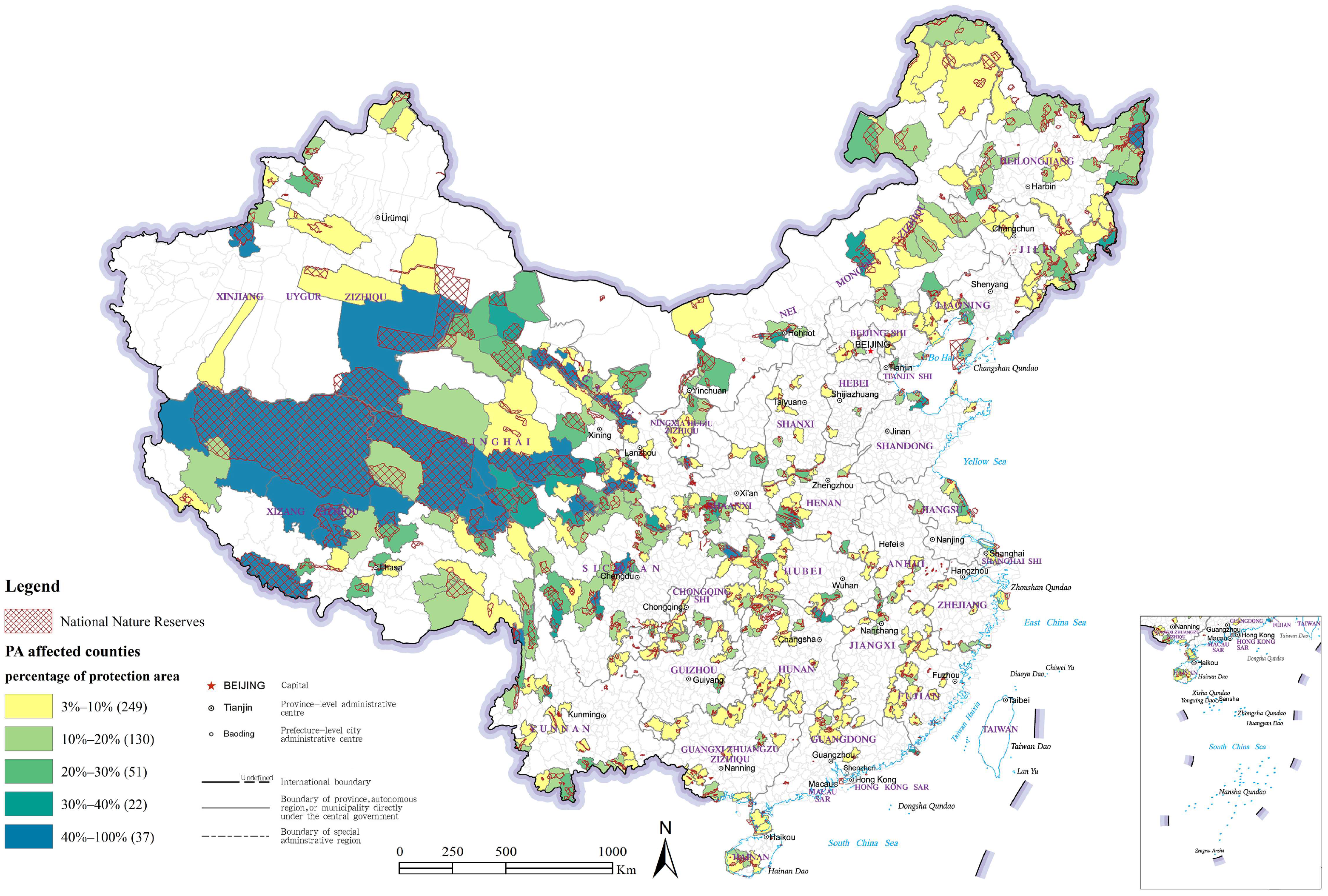
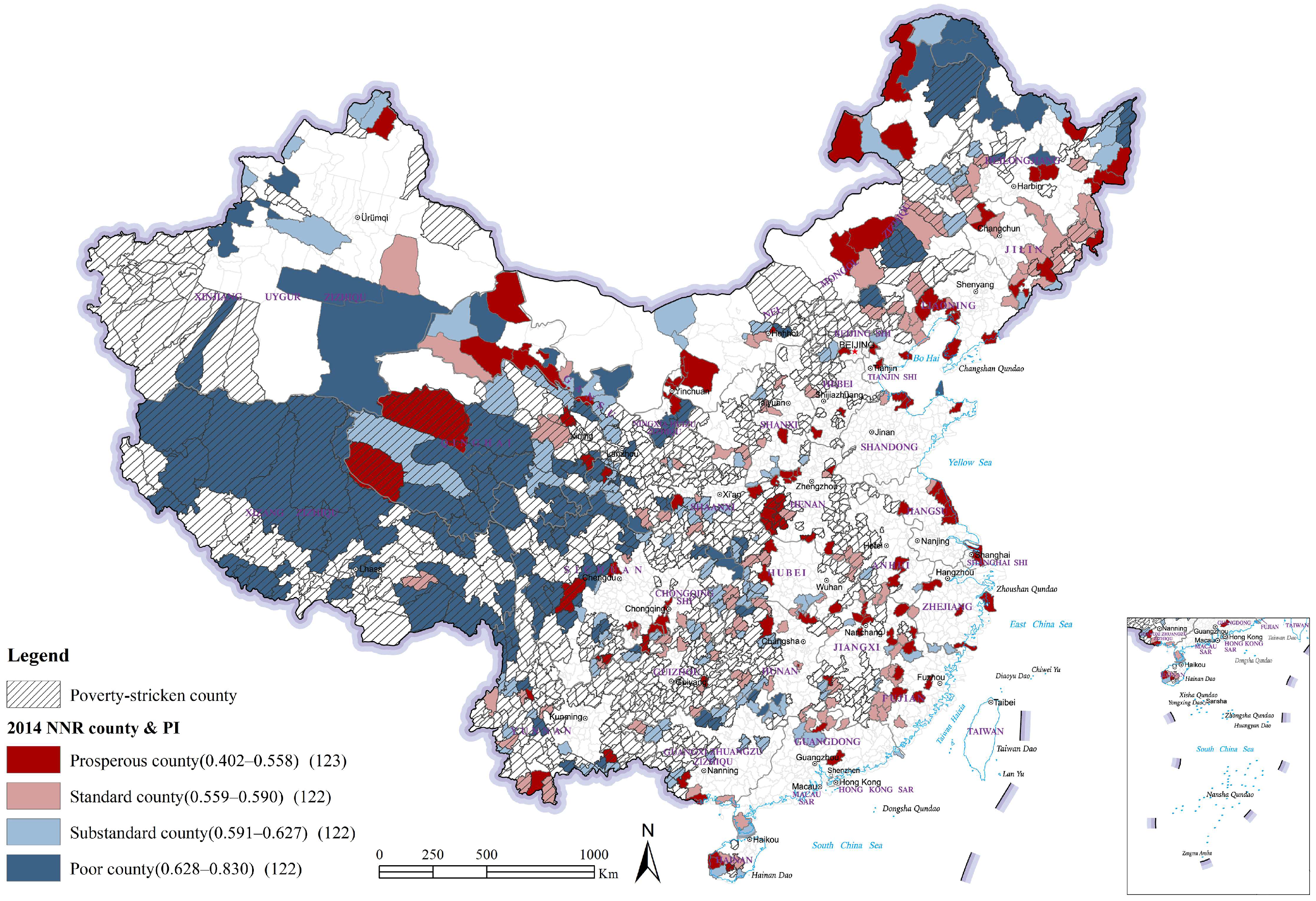
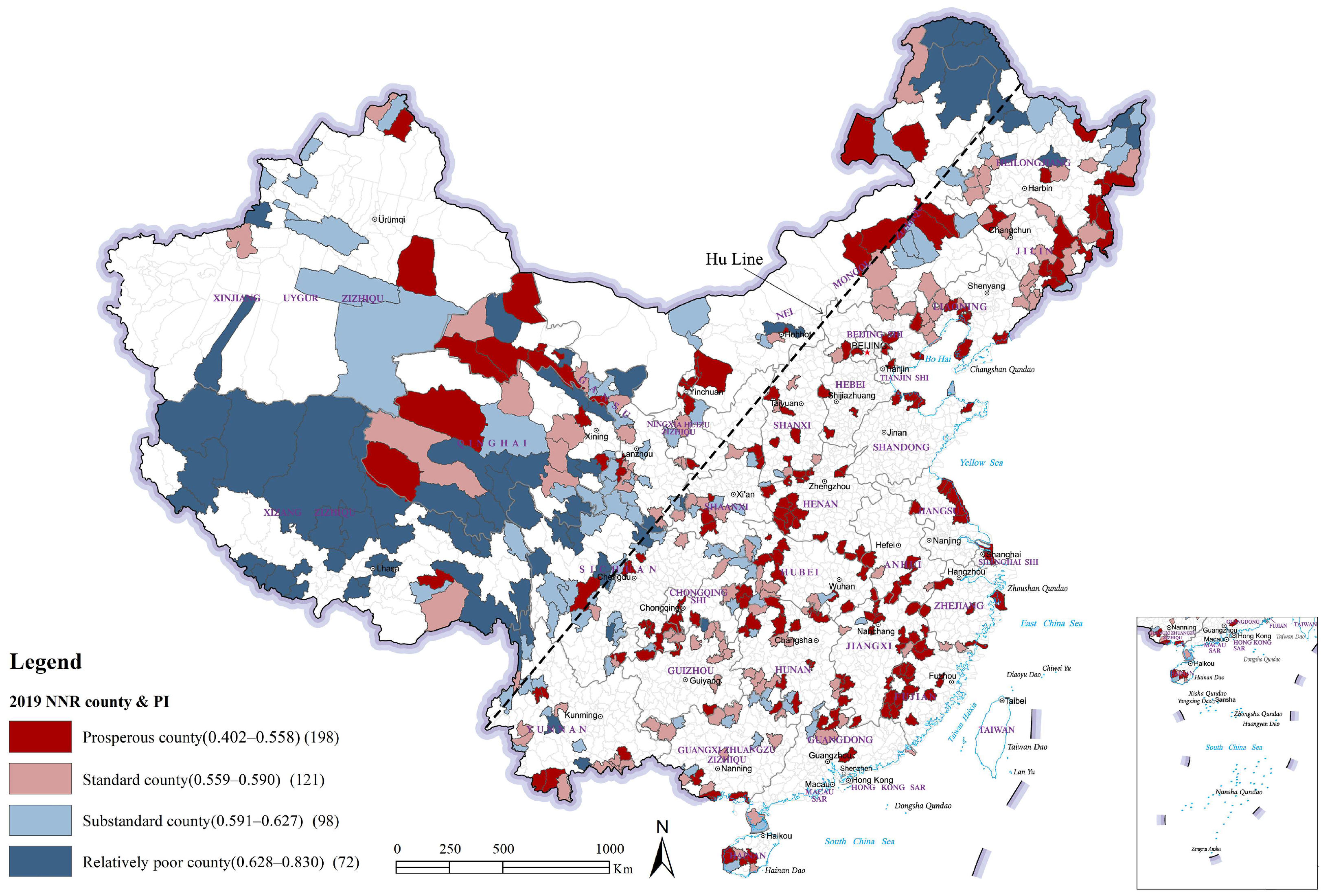


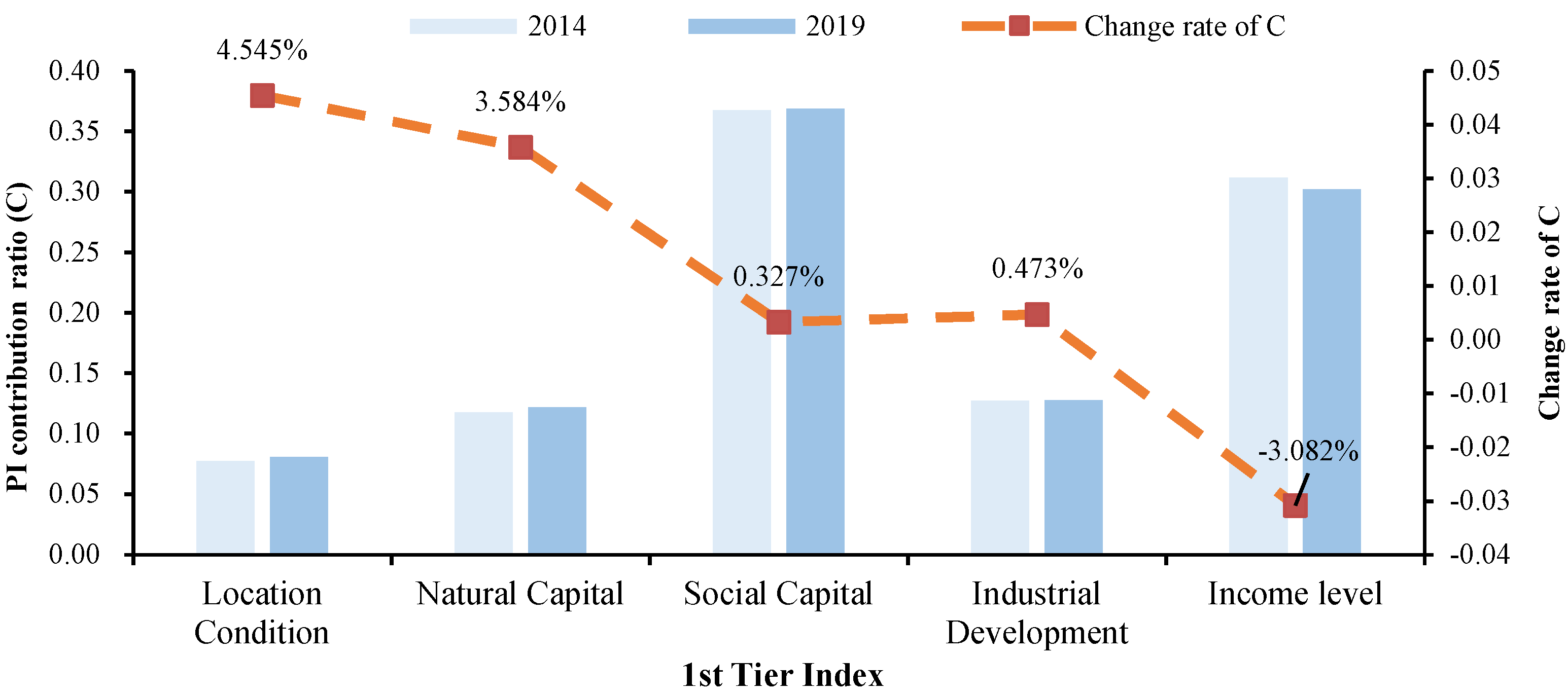
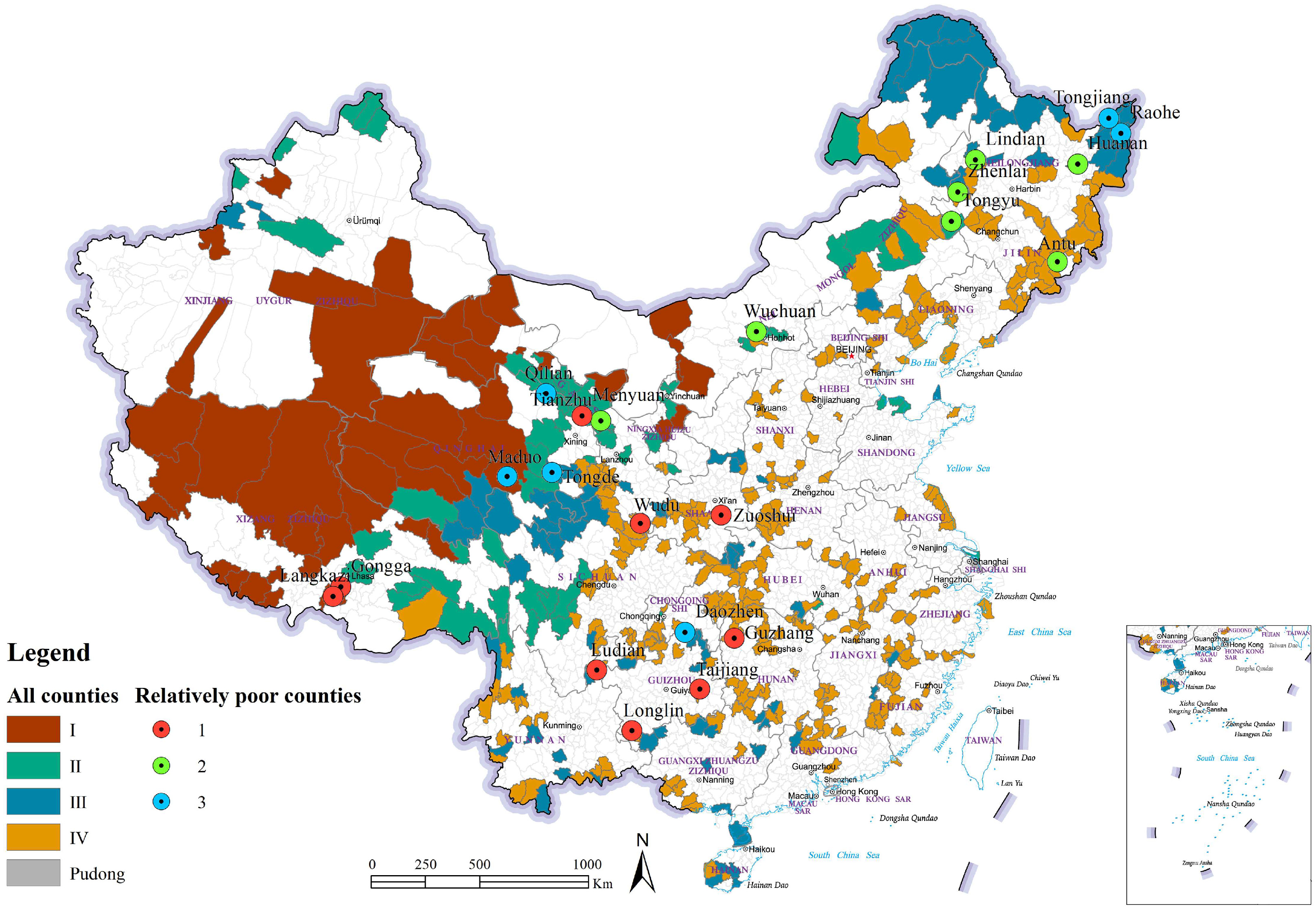
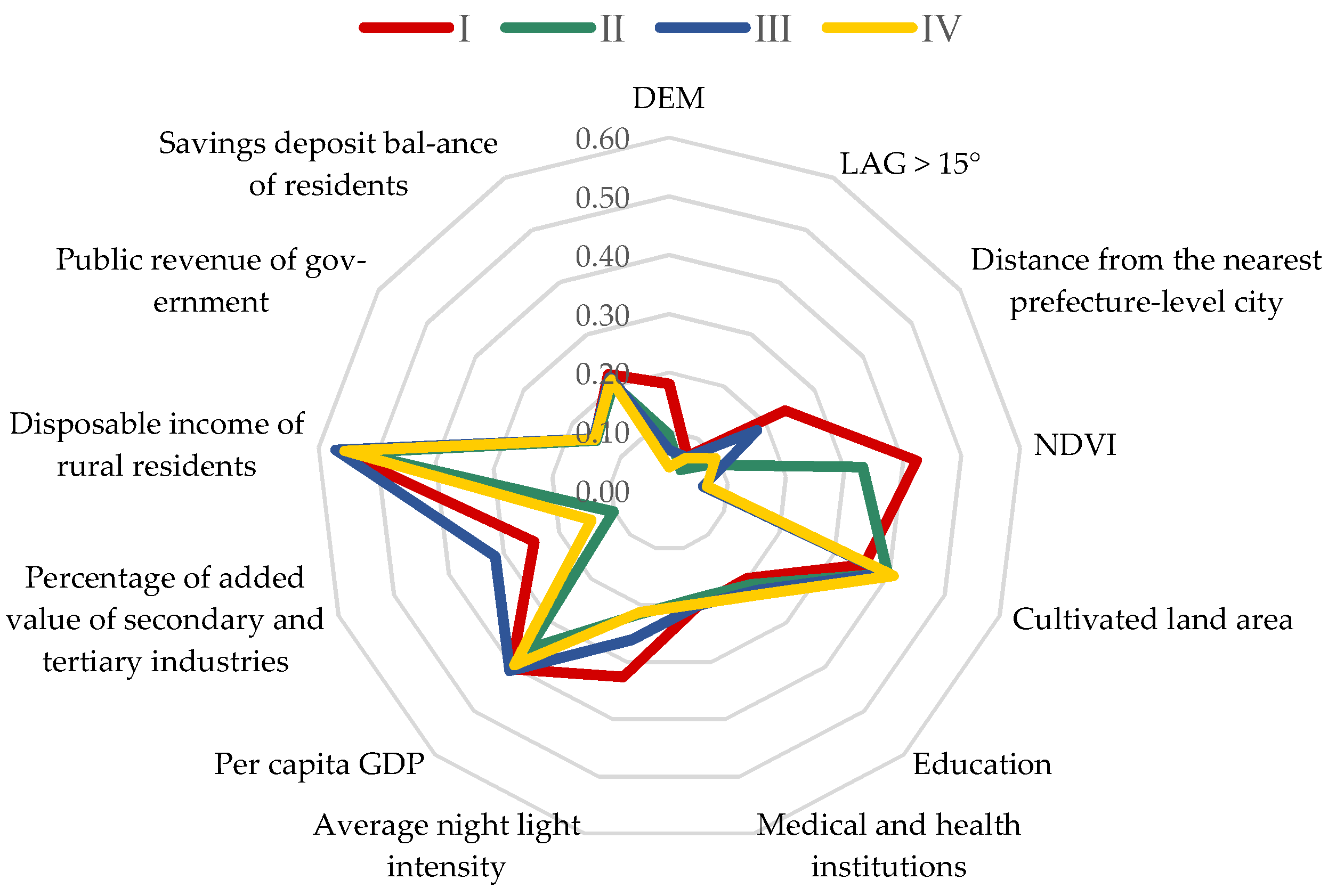

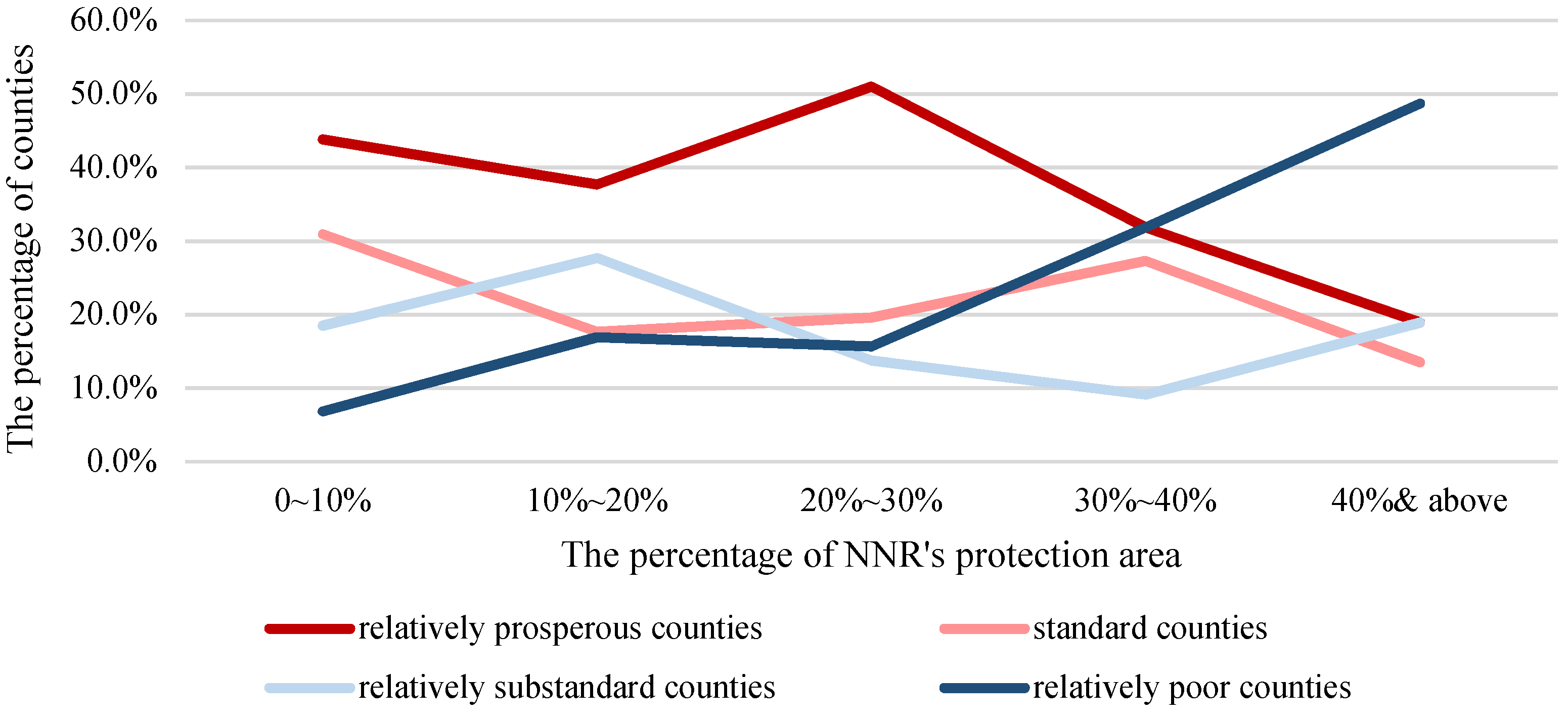
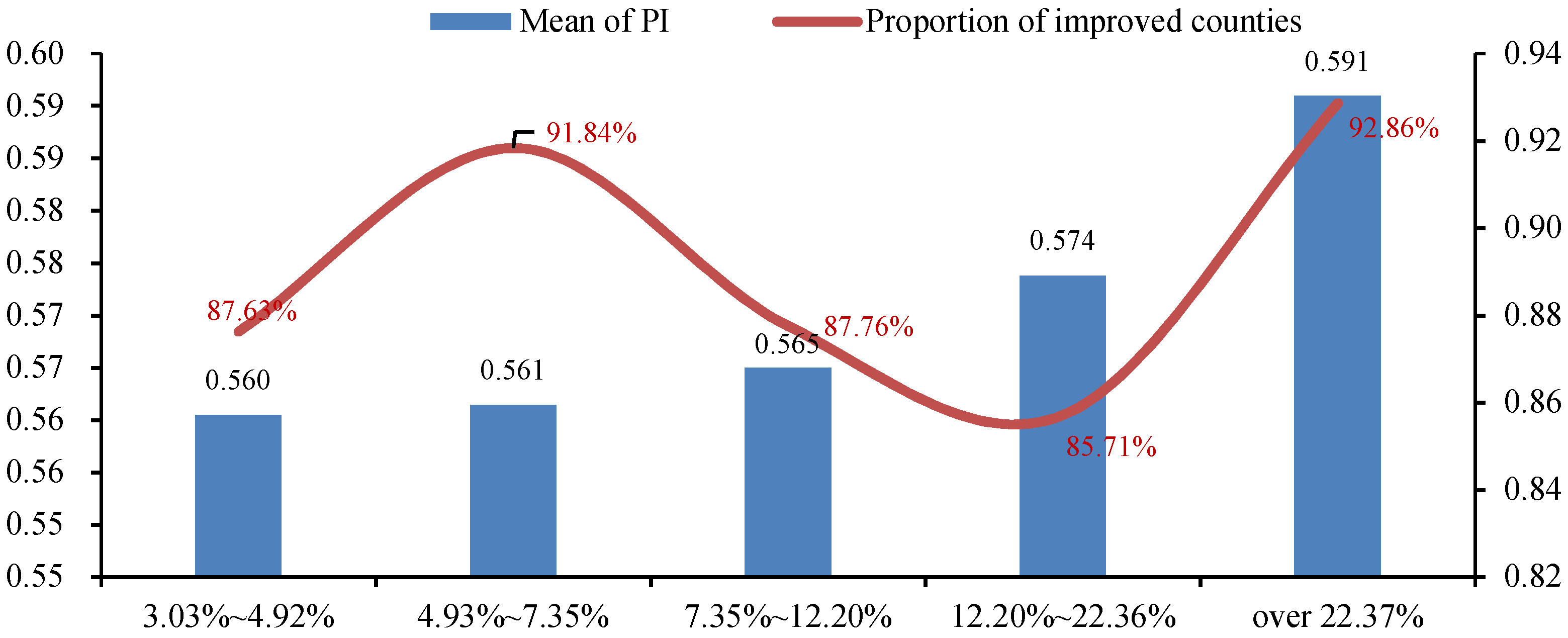
| System | Weight | 1st Tier Index | 2nd Tier Index | Unit | Direction | AHP (u) | EVM (v) | Indicator Description | ||
|---|---|---|---|---|---|---|---|---|---|---|
| Natural Environment (N) | 1 | Nature Resource | 0.4 | NDVI average value (NDVI) | \ | - | 0.349 | 0.941 | 0.586 | Reflect the surface vegetation coverage |
| per capita cultivated land area (CLA) | Hectare | - | 0.651 | 0.059 | 0.414 | Reflect the supporting capacity of cultivated land resources for poverty alleviation | ||||
| Geographical Conditions | 0.6 | elevation (DEM) | m | + | 0.171 | 0.364 | 0.229 | The higher the elevation is, the worse the living conditions are | ||
| percentage of land area with gradient >15° (LAG > 15°) | % | + | 0.185 | 0.353 | 0.235 | Reflect the percentage of difficult-to-use land | ||||
| Distance from the nearest prefecture-level city (DC) | km | + | 0.644 | 0.283 | 0.536 | Reflect the traffic location; the farther the distance is, the higher the cost of industrial development is | ||||
| Economy(E) | 1 | Industrial Development | 0.4 | per capita GDP | 10k yuan | - | 0.546 | 0.147 | 0.426 | Reflect the level of regional social and economic development |
| percentage of added value of secondary and tertiary industries (PSTI) | % | - | 0.454 | 0.853 | 0.574 | Driving force of sustainable poverty alleviation | ||||
| Income Level | 0.6 | Per capita public revenue of government (PRG) | yuan | - | 0.148 | 0.190 | 0.156 | Government revenue capacity | ||
| Per capita disposable income of rural residents (DIRR) | yuan | - | 0.670 | 0.374 | 0.611 | Reflect the income level of rural community | ||||
| Per capita savings deposit balance of residents within entire county (SDBR) | yuan | - | 0.182 | 0.435 | 0.233 | Reflect the overall income level of the country | ||||
| Society(S) | 1 | Social Capital | 1 | Number of students per 10k people (Education) | \ | - | 0.358 | 0.341 | 0.353 | Popularization of education |
| Number of beds in medical and health institutions per 10k people (MHI) | \ | - | 0.248 | 0.198 | 0.233 | Reflect the level of medical security | ||||
| Average night light intensity (ANLI) | \ | - | 0.394 | 0.461 | 0.414 | Reflect human activities and urban built-up area |
| Indicators | Moran’s I | Z | ||
|---|---|---|---|---|
| 2014 | 2019 | 2014 | 2019 | |
| PI | 0.304 | 0.297 | 16.219 | 15.850 |
| N | 0.395 | 0.389 | 21.028 | 20.763 |
| E | 0.264 | 0.269 | 14.102 | 14.550 |
| S | 0.121 | 0.099 | 6.524 | 5.341 |
| Index | F (Unweighted Regression) | F (Weighted Regression) |
|---|---|---|
| Elevation (DEM) | 123.73 *** | 143.83 *** |
| Percentage of land area with gradient >15° | 6.29 *** | 39.81 *** |
| Distance from the nearest prefecture-level city | 8.51 *** | 98.34 *** |
| NDVI average value | 992.32 *** | 481.31 *** |
| Per capita cultivated land area | 21.04 *** | 25.83 *** |
| Number of students per 10,000 people | 6.38 *** | 5.39 *** |
| Number of beds in medical and health institutions per 10,000 people | 4.96 *** | 6.98 *** |
| Average night light intensity | 10.79 *** | 84.29 *** |
| Per capita GDP | 45.14 *** | 46.77 *** |
| Percentage of added value of secondary and tertiary industries | 0.54 | 6.90 *** |
| Per capita disposable income of rural residents | 47.67 *** | 26.28 *** |
| Per capita public revenue | 217.59 *** | 26.95 *** |
| Per capita savings deposit balance of residents | 26.22 *** | 23.78 *** |
| Index | Cluster Center | Ms | |||
|---|---|---|---|---|---|
| I | II | III | IV | ||
| Elevation (DEM) | 0.07 | 0.04 | 0.20 | 0.07 | 0.29 |
| Percentage of land area with gradient >15° | 0.10 | 0.05 | 0.09 | 0.02 | 0.11 |
| Distance from the nearest prefecture-level city | 0.20 | 0.07 | 0.19 | 0.10 | 0.53 |
| NDVI average value | 0.05 | 0.07 | 0.35 | 0.38 | 2.18 |
| Per capita cultivated land area | 0.40 | 0.41 | 0.37 | 0.39 | 0.02 |
| Number of students per 10,000 people | 0.23 | 0.24 | 0.21 | 0.23 | 0.01 |
| Number of beds in medical and health institutions per 10,000 people | 0.20 | 0.19 | 0.20 | 0.18 | 0.01 |
| Average night light intensity | 0.25 | 0.21 | 0.35 | 0.20 | 0.25 |
| Per capita GDP | 0.51 | 0.49 | 0.51 | 0.42 | 0.09 |
| Percentage of added value of secondary and tertiary industries | 0.34 | 0.33 | 0.34 | 0.33 | 0.01 |
| Per capita disposable income of rural residents | 0.13 | 0.13 | 0.14 | 0.12 | 0.00 |
| Per capita public revenue | 0.60 | 0.60 | 0.60 | 0.57 | 0.01 |
| Per capita savings deposit balance of residents | 0.20 | 0.20 | 0.22 | 0.18 | 0.01 |
| Cluster | Counties |
|---|---|
| 1 | Guzhang, Longlin, Taijiang, Ludian, Gongga, Langkazi, Zuoshui, Wudu, and Menyuan |
| 2 | Wuchuan, Zhenlai, Tongyu, Antu, Lindian, Huanan, and Tianzhu |
| 3 | Raohe, Tongjiang, Daozhen, Qilian, Tongde, and Maduo |
| Type | Percentage of Protected Area% | GDP per Capita/Yuan | Per Capita Disposable Income of Rural Residents/Yuan | Number of Students in School per 10,000 People | Number of Beds in Medical and Health Institutions per 10,000 People |
|---|---|---|---|---|---|
| Relatively poor counties | 23.74% | 23,538.01 | 9574 | 1283 | 58 |
| Non-poor counties | 12.73% | 53,685.90 | 12,031 | 1116 | 176 |
Publisher’s Note: MDPI stays neutral with regard to jurisdictional claims in published maps and institutional affiliations. |
© 2022 by the authors. Licensee MDPI, Basel, Switzerland. This article is an open access article distributed under the terms and conditions of the Creative Commons Attribution (CC BY) license (https://creativecommons.org/licenses/by/4.0/).
Share and Cite
He, X.; Li, A.; Li, J.; Zhuang, Y. Conservation and Development: Spatial Identification of Relative Poverty Areas Affected by Protected Areas in China and Its Spatiotemporal Evolutionary Characteristics. Land 2022, 11, 1048. https://doi.org/10.3390/land11071048
He X, Li A, Li J, Zhuang Y. Conservation and Development: Spatial Identification of Relative Poverty Areas Affected by Protected Areas in China and Its Spatiotemporal Evolutionary Characteristics. Land. 2022; 11(7):1048. https://doi.org/10.3390/land11071048
Chicago/Turabian StyleHe, Xi, Aoxue Li, Junhong Li, and Youbo Zhuang. 2022. "Conservation and Development: Spatial Identification of Relative Poverty Areas Affected by Protected Areas in China and Its Spatiotemporal Evolutionary Characteristics" Land 11, no. 7: 1048. https://doi.org/10.3390/land11071048
APA StyleHe, X., Li, A., Li, J., & Zhuang, Y. (2022). Conservation and Development: Spatial Identification of Relative Poverty Areas Affected by Protected Areas in China and Its Spatiotemporal Evolutionary Characteristics. Land, 11(7), 1048. https://doi.org/10.3390/land11071048






